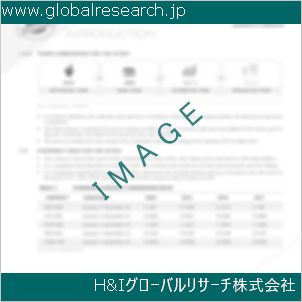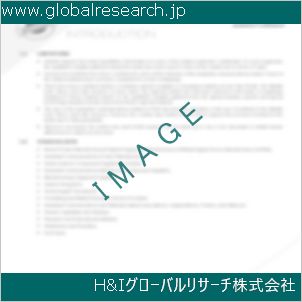1 市場概要
1.1 製品概要と範囲
1.2 市場推定の注意点と基準年
1.3 タイプ別市場分析
1.3.1 概要:グローバル低粘度セルロースエーテルの消費量(種類別):2020年対2024年対2031年
1.3.2 イオン型
1.3.3 非イオン型
1.4 用途別市場分析
1.4.1 概要:グローバル低粘度セルロースエーテルの消費量(用途別):2020年対2024年対2031年
1.4.2 水性塗料
1.4.3 石膏系
1.5 グローバル低粘度セルロースエーテル市場規模と予測
1.5.1 グローバル低粘度セルロースエーテル消費量(2020年、2024年、2031年)
1.5.2 グローバル低粘度セルロースエーテル販売量(2020年~2031年)
1.5.3 グローバル低粘度セルロースエーテル平均価格(2020-2031)
2 メーカープロファイル
2.1 DOW CHEMICAL
2.1.1 DOW CHEMICAL 詳細
2.1.2 DOW CHEMICAL 主な事業
2.1.3 DOW CHEMICAL 低粘度セルロースエーテル製品とサービス
2.1.4 DOW CHEMICAL 低粘度セルロースエーテルの売上数量、平均価格、売上高、粗利益率、市場シェア(2020-2025)
2.1.5 DOW CHEMICAL 最近の動向/更新
2.2 ペンタケム
2.2.1 ペンタケムの詳細
2.2.2 ペンタケム 主な事業
2.2.3 ペンタケム 低粘度セルロースエーテル製品およびサービス
2.2.4 ペンタケム 低粘度セルロースエーテルの売上数量、平均価格、売上高、粗利益率、市場シェア(2020-2025)
2.2.5 PENTACHEM の最近の動向/更新
2.3 Celotech
2.3.1 Celotechの詳細
2.3.2 Celotech 主な事業
2.3.3 Celotech 低粘度セルロースエーテル製品およびサービス
2.3.4 Celotech 低粘度セルロースエーテルの売上数量、平均価格、売上高、粗利益率、市場シェア(2020-2025)
2.3.5 Celotechの最近の動向/更新
2.4 ShinEtsu
2.4.1 ShinEtsuの詳細
2.4.2 ShinEtsu 主な事業
2.4.3 ShinEtsu 低粘度セルロースエーテル製品およびサービス
2.4.4 ShinEtsu 低粘度セルロースエーテルの売上数量、平均価格、売上高、粗利益率、市場シェア(2020-2025)
2.4.5 ShinEtsuの最近の動向/更新
2.5 キマケミカル
2.5.1 キマケミカルの概要
2.5.2 キマケミカルの主要事業
2.5.3 キマケミカル 低粘度セルロースエーテル製品およびサービス
2.5.4 キマケミカル 低粘度セルロースエーテルの売上数量、平均価格、売上高、粗利益率、市場シェア(2020-2025)
2.5.5 キマ・ケミカルの最近の動向/更新
2.6 ユンソン・ケミストリー
2.6.1 ユンソン・ケミカルの概要
2.6.2 ユンソン・ケミカルの主要事業
2.6.3 ユンソン・ケミカルの低粘度セルロースエーテル製品およびサービス
2.6.4 ユンソン・ケミカルの低粘度セルロースエーテルの売上数量、平均価格、売上高、粗利益率、市場シェア(2020-2025)
2.6.5 ユンソン化学の最近の動向/更新
2.7 SE Tylose GmbH & Co. KG
2.7.1 SE Tylose GmbH & Co. KG 詳細
2.7.2 SE Tylose GmbH & Co. KG 主な事業
2.7.3 SE Tylose GmbH & Co. KG 低粘度セルロースエーテル製品およびサービス
2.7.4 SE Tylose GmbH & Co. KG 低粘度セルロースエーテルの売上数量、平均価格、売上高、粗利益率、市場シェア(2020-2025)
2.7.5 SE Tylose GmbH & Co. KG 最近の動向/更新
2.8 Lotte Fine Chemical
2.8.1 Lotte Fine Chemical 詳細
2.8.2 Lotte Fine Chemical 主な事業
2.8.3 Lotte Fine Chemical 低粘度セルロースエーテル製品およびサービス
2.8.4 Lotte Fine Chemical 低粘度セルロースエーテルの売上数量、平均価格、売上高、粗利益率、市場シェア(2020-2025)
2.8.5 ロッテファインケミカルの最近の動向/更新
2.9 シドリー化学
2.9.1 シドリー化学の詳細
2.9.2 シドリー化学の主要事業
2.9.3 シドリー・ケミカル 低粘度セルロースエーテル製品およびサービス
2.9.4 シドリー化学 低粘度セルロースエーテルの売上数量、平均価格、売上高、粗利益率、市場シェア(2020-2025)
2.9.5 シドリー・ケミカルの最近の動向/更新情報
2.10 河北宜邦建築材料
2.10.1 河北宜邦建築材料の詳細
2.10.2 河北宜邦建築材料 主な事業
2.10.3 河北宜邦建築材料 低粘度セルロースエーテル製品およびサービス
2.10.4 河北宜邦建設材料 低粘度セルロースエーテルの販売量、平均価格、売上高、粗利益率、市場シェア(2020-2025)
2.10.5 河北宜邦建築材料の最近の動向/更新
2.11 南京スタブル
2.11.1 南京スタブル 詳細
2.11.2 南京スタビライザー主要事業
2.11.3 南京スタブル 低粘度セルロースエーテル製品およびサービス
2.11.4 南京スタブル低粘度セルロースエーテルの売上数量、平均価格、売上高、粗利益率、市場シェア(2020-2025)
2.11.5 南京スタビライザーの最近の動向/更新
2.12 山東ヘッド
2.12.1 山東ヘッドの詳細
2.12.2 山東ヘッド主要事業
2.12.3 山東ヘッド低粘度セルロースエーテル製品およびサービス
2.12.4 山東ヘッド低粘度セルロースエーテルの売上数量、平均価格、売上高、粗利益率、市場シェア(2020-2025)
2.12.5 山東ヘッドの最近の動向/更新
2.13 浙江省ケホン化学
2.13.1 浙江省ケホン化学の詳細
2.13.2 浙江省ケホン化学の主要事業
2.13.3 浙江省ケホン化学 低粘度セルロースエーテル製品およびサービス
2.13.4 浙江省ケホン化学 低粘度セルロースエーテルの売上数量、平均価格、売上高、粗利益率、市場シェア(2020-2025)
2.13.5 浙江省ケホン化学の最近の動向/更新
3 競争環境:製造業者別低粘度セルロースエーテル
3.1 グローバル低粘度セルロースエーテルの製造業者別販売量(2020-2025)
3.2 グローバル低粘度セルロースエーテルの売上高(メーカー別)(2020-2025)
3.3 グローバル低粘度セルロースエーテルの平均価格(メーカー別)(2020-2025)
3.4 市場シェア分析(2024年)
3.4.1 低粘度セルロースエーテルの製造メーカー別出荷量(売上高:$MM)と市場シェア(%):2024
3.4.2 2024年の低粘度セルロースエーテル製造業者上位3社の市場シェア
3.4.3 2024年の低粘度セルロースエーテルメーカー上位6社の市場シェア
3.5 低粘度セルロースエーテル市場:全体的な企業足跡分析
3.5.1 低粘度セルロースエーテル市場:地域別足跡
3.5.2 低粘度セルロースエーテル市場:企業製品タイプ別足跡
3.5.3 低粘度セルロースエーテル市場:企業製品用途別足跡
3.6 新規参入企業と市場参入障壁
3.7 合併、買収、合意、および協力関係
4 地域別消費分析
4.1 地域別低粘度セルロースエーテル市場規模
4.1.1 地域別低粘度セルロースエーテル販売量(2020-2031)
4.1.2 地域別低粘度セルロースエーテル消費額(2020-2031)
4.1.3 地域別低粘度セルロースエーテルの平均価格(2020-2031)
4.2 北米低粘度セルロースエーテル消費額(2020-2031)
4.3 欧州の低粘度セルロースエーテル消費量(2020-2031)
4.4 アジア太平洋地域 低粘度セルロースエーテルの消費量(2020-2031)
4.5 南米 低粘度セルロースエーテルの消費額(2020-2031)
4.6 中東・アフリカ地域 低粘度セルロースエーテル消費量(2020-2031)
5 市場セグメント別タイプ
5.1 グローバル低粘度セルロースエーテル販売量(タイプ別)(2020-2031)
5.2 グローバル低粘度セルロースエーテルの消費量(種類別)(2020-2031)
5.3 グローバル低粘度セルロースエーテルの平均価格(種類別)(2020-2031)
6 市場セグメント(用途別)
6.1 グローバル低粘度セルロースエーテルの用途別販売量(2020-2031)
6.2 低粘度セルロースエーテルの用途別消費額(2020-2031)
6.3 低粘度セルロースエーテルの用途別平均価格(2020-2031)
7 北米
7.1 北米 低粘度セルロースエーテルの売上数量(種類別)(2020-2031)
7.2 北米低粘度セルロースエーテルの用途別販売量(2020-2031)
7.3 北米低粘度セルロースエーテル市場規模(国別)
7.3.1 北米 低粘度セルロースエーテルの販売量(国別)(2020-2031)
7.3.2 北米低粘度セルロースエーテルの消費額(国別)(2020-2031)
7.3.3 アメリカ市場規模と予測(2020-2031)
7.3.4 カナダ市場規模と予測(2020-2031)
7.3.5 メキシコ市場規模と予測(2020-2031)
8 ヨーロッパ
8.1 欧州 低粘度セルロースエーテルのタイプ別販売量(2020-2031)
8.2 欧州低粘度セルロースエーテルの用途別販売量(2020-2031)
8.3 欧州低粘度セルロースエーテル市場規模(国別)
8.3.1 欧州低粘度セルロースエーテルの売上数量(国別)(2020-2031)
8.3.2 欧州低粘度セルロースエーテルの消費額(国別)(2020-2031)
8.3.3 ドイツ市場規模と予測(2020-2031)
8.3.4 フランス市場規模と予測(2020-2031)
8.3.5 イギリス市場規模と予測(2020-2031)
8.3.6 ロシア市場規模と予測(2020-2031)
8.3.7 イタリア市場規模と予測(2020-2031)
9 アジア太平洋
9.1 アジア太平洋地域 低粘度セルロースエーテルの販売量(種類別)(2020-2031)
9.2 アジア太平洋地域 低粘度セルロースエーテルの販売量(用途別)(2020-2031)
9.3 アジア太平洋地域低粘度セルロースエーテル市場規模(地域別)
9.3.1 アジア太平洋地域における低粘度セルロースエーテルの販売量(地域別)(2020-2031)
9.3.2 アジア太平洋地域低粘度セルロースエーテルの地域別消費額(2020-2031)
9.3.3 中国市場規模と予測(2020-2031)
9.3.4 日本市場規模と予測(2020-2031)
9.3.5 韓国市場規模と予測(2020-2031)
9.3.6 インド市場規模と予測(2020-2031)
9.3.7 東南アジア市場規模と予測(2020-2031)
9.3.8 オーストラリア市場規模と予測(2020-2031)
10 南米
10.1 南米 低粘度セルロースエーテルの販売量(種類別)(2020-2031)
10.2 南米 低粘度セルロースエーテルの販売量(用途別)(2020-2031)
10.3 南米低粘度セルロースエーテル市場規模(国別)
10.3.1 南米低粘度セルロースエーテルの販売量(国別)(2020-2031)
10.3.2 南米 低粘度セルロースエーテルの消費額(国別)(2020-2031)
10.3.3 ブラジル市場規模と予測(2020-2031)
10.3.4 アルゼンチン市場規模と予測(2020-2031)
11 中東・アフリカ
11.1 中東・アフリカ地域 低粘度セルロースエーテルのタイプ別販売量(2020-2031年)
11.2 中東・アフリカ地域における低粘度セルロースエーテルの用途別販売量(2020-2031年)
11.3 中東・アフリカ地域における低粘度セルロースエーテル市場規模(国別)
11.3.1 中東・アフリカ地域 低粘度セルロースエーテルの売上数量(国別)(2020-2031)
11.3.2 中東・アフリカ地域 低粘度セルロースエーテルの消費額(国別)(2020-2031)
11.3.3 トルコ市場規模と予測(2020-2031)
11.3.4 エジプト市場規模と予測(2020-2031)
11.3.5 サウジアラビア市場規模と予測(2020-2031)
11.3.6 南アフリカ市場規模と予測(2020-2031)
12 市場動向
12.1 低粘度セルロースエーテル市場ドライバー
12.2 低粘度セルロースエーテル市場を制約する要因
12.3 低粘度セルロースエーテルの動向分析
12.4 ポーターの5つの力分析
12.4.1 新規参入の脅威
12.4.2 供給者の交渉力
12.4.3 購入者の交渉力
12.4.4 代替品の脅威
12.4.5 競争の激化
13 原材料と産業チェーン
13.1 低粘度セルロースエーテルの原材料と主要メーカー
13.2 低粘度セルロースエーテルの製造コストの割合
13.3 低粘度セルロースエーテルの製造プロセス
13.4 産業バリューチェーン分析
14 流通チャネル別出荷量
14.1 販売チャネル
14.1.1 直接エンドユーザー向け
14.1.2 卸売業者
14.2 低粘度セルロースエーテルの典型的な卸売業者
14.3 低粘度セルロースエーテルの典型的な顧客
15 研究結果と結論
16 付録
16.1 方法論
16.2 研究プロセスとデータソース
16.3 免責事項
1.1 Product Overview and Scope
1.2 Market Estimation Caveats and Base Year
1.3 Market Analysis by Type
1.3.1 Overview: Global Low Viscosity Cellulose Ether Consumption Value by Type: 2020 Versus 2024 Versus 2031
1.3.2 Ionic Type
1.3.3 Non-ionic Type
1.4 Market Analysis by Application
1.4.1 Overview: Global Low Viscosity Cellulose Ether Consumption Value by Application: 2020 Versus 2024 Versus 2031
1.4.2 Water-based Paint
1.4.3 Gypsum Base
1.5 Global Low Viscosity Cellulose Ether Market Size & Forecast
1.5.1 Global Low Viscosity Cellulose Ether Consumption Value (2020 & 2024 & 2031)
1.5.2 Global Low Viscosity Cellulose Ether Sales Quantity (2020-2031)
1.5.3 Global Low Viscosity Cellulose Ether Average Price (2020-2031)
2 Manufacturers Profiles
2.1 DOW CHEMICAL
2.1.1 DOW CHEMICAL Details
2.1.2 DOW CHEMICAL Major Business
2.1.3 DOW CHEMICAL Low Viscosity Cellulose Ether Product and Services
2.1.4 DOW CHEMICAL Low Viscosity Cellulose Ether Sales Quantity, Average Price, Revenue, Gross Margin and Market Share (2020-2025)
2.1.5 DOW CHEMICAL Recent Developments/Updates
2.2 PENTACHEM
2.2.1 PENTACHEM Details
2.2.2 PENTACHEM Major Business
2.2.3 PENTACHEM Low Viscosity Cellulose Ether Product and Services
2.2.4 PENTACHEM Low Viscosity Cellulose Ether Sales Quantity, Average Price, Revenue, Gross Margin and Market Share (2020-2025)
2.2.5 PENTACHEM Recent Developments/Updates
2.3 Celotech
2.3.1 Celotech Details
2.3.2 Celotech Major Business
2.3.3 Celotech Low Viscosity Cellulose Ether Product and Services
2.3.4 Celotech Low Viscosity Cellulose Ether Sales Quantity, Average Price, Revenue, Gross Margin and Market Share (2020-2025)
2.3.5 Celotech Recent Developments/Updates
2.4 ShinEtsu
2.4.1 ShinEtsu Details
2.4.2 ShinEtsu Major Business
2.4.3 ShinEtsu Low Viscosity Cellulose Ether Product and Services
2.4.4 ShinEtsu Low Viscosity Cellulose Ether Sales Quantity, Average Price, Revenue, Gross Margin and Market Share (2020-2025)
2.4.5 ShinEtsu Recent Developments/Updates
2.5 Kima Chemical
2.5.1 Kima Chemical Details
2.5.2 Kima Chemical Major Business
2.5.3 Kima Chemical Low Viscosity Cellulose Ether Product and Services
2.5.4 Kima Chemical Low Viscosity Cellulose Ether Sales Quantity, Average Price, Revenue, Gross Margin and Market Share (2020-2025)
2.5.5 Kima Chemical Recent Developments/Updates
2.6 Yunsong Chemistry
2.6.1 Yunsong Chemistry Details
2.6.2 Yunsong Chemistry Major Business
2.6.3 Yunsong Chemistry Low Viscosity Cellulose Ether Product and Services
2.6.4 Yunsong Chemistry Low Viscosity Cellulose Ether Sales Quantity, Average Price, Revenue, Gross Margin and Market Share (2020-2025)
2.6.5 Yunsong Chemistry Recent Developments/Updates
2.7 SE Tylose GmbH & Co. KG
2.7.1 SE Tylose GmbH & Co. KG Details
2.7.2 SE Tylose GmbH & Co. KG Major Business
2.7.3 SE Tylose GmbH & Co. KG Low Viscosity Cellulose Ether Product and Services
2.7.4 SE Tylose GmbH & Co. KG Low Viscosity Cellulose Ether Sales Quantity, Average Price, Revenue, Gross Margin and Market Share (2020-2025)
2.7.5 SE Tylose GmbH & Co. KG Recent Developments/Updates
2.8 Lotte Fine Chemical
2.8.1 Lotte Fine Chemical Details
2.8.2 Lotte Fine Chemical Major Business
2.8.3 Lotte Fine Chemical Low Viscosity Cellulose Ether Product and Services
2.8.4 Lotte Fine Chemical Low Viscosity Cellulose Ether Sales Quantity, Average Price, Revenue, Gross Margin and Market Share (2020-2025)
2.8.5 Lotte Fine Chemical Recent Developments/Updates
2.9 Sidley Chemical
2.9.1 Sidley Chemical Details
2.9.2 Sidley Chemical Major Business
2.9.3 Sidley Chemical Low Viscosity Cellulose Ether Product and Services
2.9.4 Sidley Chemical Low Viscosity Cellulose Ether Sales Quantity, Average Price, Revenue, Gross Margin and Market Share (2020-2025)
2.9.5 Sidley Chemical Recent Developments/Updates
2.10 Hebei Yibang Building MATERIALS
2.10.1 Hebei Yibang Building MATERIALS Details
2.10.2 Hebei Yibang Building MATERIALS Major Business
2.10.3 Hebei Yibang Building MATERIALS Low Viscosity Cellulose Ether Product and Services
2.10.4 Hebei Yibang Building MATERIALS Low Viscosity Cellulose Ether Sales Quantity, Average Price, Revenue, Gross Margin and Market Share (2020-2025)
2.10.5 Hebei Yibang Building MATERIALS Recent Developments/Updates
2.11 Nanjing Stable
2.11.1 Nanjing Stable Details
2.11.2 Nanjing Stable Major Business
2.11.3 Nanjing Stable Low Viscosity Cellulose Ether Product and Services
2.11.4 Nanjing Stable Low Viscosity Cellulose Ether Sales Quantity, Average Price, Revenue, Gross Margin and Market Share (2020-2025)
2.11.5 Nanjing Stable Recent Developments/Updates
2.12 Shandong Head
2.12.1 Shandong Head Details
2.12.2 Shandong Head Major Business
2.12.3 Shandong Head Low Viscosity Cellulose Ether Product and Services
2.12.4 Shandong Head Low Viscosity Cellulose Ether Sales Quantity, Average Price, Revenue, Gross Margin and Market Share (2020-2025)
2.12.5 Shandong Head Recent Developments/Updates
2.13 Zhejiang Kehong Chemical
2.13.1 Zhejiang Kehong Chemical Details
2.13.2 Zhejiang Kehong Chemical Major Business
2.13.3 Zhejiang Kehong Chemical Low Viscosity Cellulose Ether Product and Services
2.13.4 Zhejiang Kehong Chemical Low Viscosity Cellulose Ether Sales Quantity, Average Price, Revenue, Gross Margin and Market Share (2020-2025)
2.13.5 Zhejiang Kehong Chemical Recent Developments/Updates
3 Competitive Environment: Low Viscosity Cellulose Ether by Manufacturer
3.1 Global Low Viscosity Cellulose Ether Sales Quantity by Manufacturer (2020-2025)
3.2 Global Low Viscosity Cellulose Ether Revenue by Manufacturer (2020-2025)
3.3 Global Low Viscosity Cellulose Ether Average Price by Manufacturer (2020-2025)
3.4 Market Share Analysis (2024)
3.4.1 Producer Shipments of Low Viscosity Cellulose Ether by Manufacturer Revenue ($MM) and Market Share (%): 2024
3.4.2 Top 3 Low Viscosity Cellulose Ether Manufacturer Market Share in 2024
3.4.3 Top 6 Low Viscosity Cellulose Ether Manufacturer Market Share in 2024
3.5 Low Viscosity Cellulose Ether Market: Overall Company Footprint Analysis
3.5.1 Low Viscosity Cellulose Ether Market: Region Footprint
3.5.2 Low Viscosity Cellulose Ether Market: Company Product Type Footprint
3.5.3 Low Viscosity Cellulose Ether Market: Company Product Application Footprint
3.6 New Market Entrants and Barriers to Market Entry
3.7 Mergers, Acquisition, Agreements, and Collaborations
4 Consumption Analysis by Region
4.1 Global Low Viscosity Cellulose Ether Market Size by Region
4.1.1 Global Low Viscosity Cellulose Ether Sales Quantity by Region (2020-2031)
4.1.2 Global Low Viscosity Cellulose Ether Consumption Value by Region (2020-2031)
4.1.3 Global Low Viscosity Cellulose Ether Average Price by Region (2020-2031)
4.2 North America Low Viscosity Cellulose Ether Consumption Value (2020-2031)
4.3 Europe Low Viscosity Cellulose Ether Consumption Value (2020-2031)
4.4 Asia-Pacific Low Viscosity Cellulose Ether Consumption Value (2020-2031)
4.5 South America Low Viscosity Cellulose Ether Consumption Value (2020-2031)
4.6 Middle East & Africa Low Viscosity Cellulose Ether Consumption Value (2020-2031)
5 Market Segment by Type
5.1 Global Low Viscosity Cellulose Ether Sales Quantity by Type (2020-2031)
5.2 Global Low Viscosity Cellulose Ether Consumption Value by Type (2020-2031)
5.3 Global Low Viscosity Cellulose Ether Average Price by Type (2020-2031)
6 Market Segment by Application
6.1 Global Low Viscosity Cellulose Ether Sales Quantity by Application (2020-2031)
6.2 Global Low Viscosity Cellulose Ether Consumption Value by Application (2020-2031)
6.3 Global Low Viscosity Cellulose Ether Average Price by Application (2020-2031)
7 North America
7.1 North America Low Viscosity Cellulose Ether Sales Quantity by Type (2020-2031)
7.2 North America Low Viscosity Cellulose Ether Sales Quantity by Application (2020-2031)
7.3 North America Low Viscosity Cellulose Ether Market Size by Country
7.3.1 North America Low Viscosity Cellulose Ether Sales Quantity by Country (2020-2031)
7.3.2 North America Low Viscosity Cellulose Ether Consumption Value by Country (2020-2031)
7.3.3 United States Market Size and Forecast (2020-2031)
7.3.4 Canada Market Size and Forecast (2020-2031)
7.3.5 Mexico Market Size and Forecast (2020-2031)
8 Europe
8.1 Europe Low Viscosity Cellulose Ether Sales Quantity by Type (2020-2031)
8.2 Europe Low Viscosity Cellulose Ether Sales Quantity by Application (2020-2031)
8.3 Europe Low Viscosity Cellulose Ether Market Size by Country
8.3.1 Europe Low Viscosity Cellulose Ether Sales Quantity by Country (2020-2031)
8.3.2 Europe Low Viscosity Cellulose Ether Consumption Value by Country (2020-2031)
8.3.3 Germany Market Size and Forecast (2020-2031)
8.3.4 France Market Size and Forecast (2020-2031)
8.3.5 United Kingdom Market Size and Forecast (2020-2031)
8.3.6 Russia Market Size and Forecast (2020-2031)
8.3.7 Italy Market Size and Forecast (2020-2031)
9 Asia-Pacific
9.1 Asia-Pacific Low Viscosity Cellulose Ether Sales Quantity by Type (2020-2031)
9.2 Asia-Pacific Low Viscosity Cellulose Ether Sales Quantity by Application (2020-2031)
9.3 Asia-Pacific Low Viscosity Cellulose Ether Market Size by Region
9.3.1 Asia-Pacific Low Viscosity Cellulose Ether Sales Quantity by Region (2020-2031)
9.3.2 Asia-Pacific Low Viscosity Cellulose Ether Consumption Value by Region (2020-2031)
9.3.3 China Market Size and Forecast (2020-2031)
9.3.4 Japan Market Size and Forecast (2020-2031)
9.3.5 South Korea Market Size and Forecast (2020-2031)
9.3.6 India Market Size and Forecast (2020-2031)
9.3.7 Southeast Asia Market Size and Forecast (2020-2031)
9.3.8 Australia Market Size and Forecast (2020-2031)
10 South America
10.1 South America Low Viscosity Cellulose Ether Sales Quantity by Type (2020-2031)
10.2 South America Low Viscosity Cellulose Ether Sales Quantity by Application (2020-2031)
10.3 South America Low Viscosity Cellulose Ether Market Size by Country
10.3.1 South America Low Viscosity Cellulose Ether Sales Quantity by Country (2020-2031)
10.3.2 South America Low Viscosity Cellulose Ether Consumption Value by Country (2020-2031)
10.3.3 Brazil Market Size and Forecast (2020-2031)
10.3.4 Argentina Market Size and Forecast (2020-2031)
11 Middle East & Africa
11.1 Middle East & Africa Low Viscosity Cellulose Ether Sales Quantity by Type (2020-2031)
11.2 Middle East & Africa Low Viscosity Cellulose Ether Sales Quantity by Application (2020-2031)
11.3 Middle East & Africa Low Viscosity Cellulose Ether Market Size by Country
11.3.1 Middle East & Africa Low Viscosity Cellulose Ether Sales Quantity by Country (2020-2031)
11.3.2 Middle East & Africa Low Viscosity Cellulose Ether Consumption Value by Country (2020-2031)
11.3.3 Turkey Market Size and Forecast (2020-2031)
11.3.4 Egypt Market Size and Forecast (2020-2031)
11.3.5 Saudi Arabia Market Size and Forecast (2020-2031)
11.3.6 South Africa Market Size and Forecast (2020-2031)
12 Market Dynamics
12.1 Low Viscosity Cellulose Ether Market Drivers
12.2 Low Viscosity Cellulose Ether Market Restraints
12.3 Low Viscosity Cellulose Ether Trends Analysis
12.4 Porters Five Forces Analysis
12.4.1 Threat of New Entrants
12.4.2 Bargaining Power of Suppliers
12.4.3 Bargaining Power of Buyers
12.4.4 Threat of Substitutes
12.4.5 Competitive Rivalry
13 Raw Material and Industry Chain
13.1 Raw Material of Low Viscosity Cellulose Ether and Key Manufacturers
13.2 Manufacturing Costs Percentage of Low Viscosity Cellulose Ether
13.3 Low Viscosity Cellulose Ether Production Process
13.4 Industry Value Chain Analysis
14 Shipments by Distribution Channel
14.1 Sales Channel
14.1.1 Direct to End-User
14.1.2 Distributors
14.2 Low Viscosity Cellulose Ether Typical Distributors
14.3 Low Viscosity Cellulose Ether Typical Customers
15 Research Findings and Conclusion
16 Appendix
16.1 Methodology
16.2 Research Process and Data Source
16.3 Disclaimer
| ※参考情報 低粘度セルロースエーテル(Low Viscosity Cellulose Ether)は、セルロースから派生した一群の化合物であり、主に医薬品、食品、化粧品、建築材料など、多岐にわたる分野で利用されています。低粘度セルロースエーテルは、特にその粘度が低いため、流動性が良好であり、様々な用途で非常に重要な役割を果たしています。以下にその概念について詳しく説明いたします。 まず、低粘度セルロースエーテルを定義すると、セルロースの一部のヒドロキシル基がエーテル化され、特に低粘度の特性を持つように加工された化合物です。これらのエーテルは、一般的に水溶性であり、様々な濃度の溶液作製が可能です。低粘度セルロースエーテルの特徴としては、流動性が高く、添加物としての使用において均一な分散性を持つことが挙げられます。また、熱安定性やpH安定性が高いため、様々な環境下でも性能が維持されやすいという特性もあります。 低粘度セルロースエーテルの種類には、ヒドロキシエチルセルロース(HEC)、メチルセルロース(MC)、プロピルセルロース(PC)などがあります。これらはそれぞれ異なった物理的および化学的特性を持っており、用途に応じて選ばれます。例えば、ヒドロキシエチルセルロースは、その水溶性の特性から、主に医薬品や化粧品において使用されることが多いです。また、メチルセルロースは、食品業界において、乳化剤や安定剤として広く利用されています。プロピルセルロースは、主に酸化防止剤や増粘剤としての利用が多いです。 低粘度セルロースエーテルは、様々な用途があり、その応用分野は広範です。その一つは医薬品分野です。低粘度セルロースエーテルは、製剤の粘度を調整し、配合成分の安定性を向上させるために使用されます。具体的には、経口薬や外用薬において、薬剤の放出速度を制御するための基材として利用されることが多いです。 食品分野においても、低粘度セルロースエーテルは重要な役割を果たしています。食品添加物として使用され、食感の改善や水分保持、安定剤として機能します。例えば、アイスクリームやソース類の製造において、そのクリーミーな食感を実現するために利用されることがあります。 化粧品業界でも、低粘度セルロースエーテルは多くの製品に使用されています。例えば、クリーム、ローション、ジェルなどの化粧品において、粘度調整剤やエモリエント剤として機能し、製品の使用感を向上させる役割を果たします。また、低粘度セルロースエーテルは、化粧品のテクスチャーを調整し、均一な塗布を容易にするためにも利用されています。 さらに、建材や塗料分野でも低粘度セルロースエーテルは、その特性を活かして多くの製品に配合されています。例えば、モルタルやコンクリート用の添加剤として、流動性や作業性を向上させる役割を持っています。セルロースエステルは、塗料に混合されることによって、塗膜の強度や光沢、耐水性を向上させることに貢献しています。 低粘度セルロースエーテルは、関連技術としては、様々な物理的および化学的性質を持つため、研究と開発が継続的に行われています。特に、環境に優しい製品のニーズが高まっている中で、バイオマス由来の原料を使用した低粘度セルロースエーテルの開発や、それを用いた新しい製剤技術の研究などが行われています。これにより、より持続可能な製品を市場に提供できるようになるでしょう。 以上のように、低粘度セルロースエーテルは、その多様な特性と応用範囲から、現代の産業において不可欠な材料となっています。今後もその技術革新が期待され、さらなる発展が見込まれています。ユーザーのニーズに応じた新たな製品や用途の開拓が進むことで、ますます重要性が増すことでしょう。さらに、低粘度セルロースエーテルの特性を活かした新しい製品が市場に投入されることで、様々な産業における課題解決に貢献することが期待されます。 |
❖ 免責事項 ❖
http://www.globalresearch.jp/disclaimer












